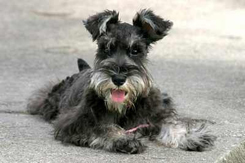|
Home- Sweet -Home Breed standard History Potty Training Help Barking Help Nipping & Biting Help
History of The Mini Schnauzer
Hi there ands welcome to a quick trip to discover the fascinating history of the Miniature Schnauzer.
The Miniature Schnauzer is the only dog in the terrier group that is not able to trace its roots back to Britain.
The German Connection The Miniature Schnauzer was originally bred in Germany, and there are pictures depicting a dog that looks very similar to a Schnauzer dating back to the fifteenth century. The original heritage of the Schnauzer is believed to be from the Wurttenberg cattle dog being crossed with either a Spitz or a Standard Poodle. These crosses could certainly account for the characteristic coat of the Schnauzer. The standard sized Schnauzer was originally called a Pinscher, but then was changed to the German word “schnauzer”, for schnauze, or snout. Most likely this was used to highlight the heavy whiskers that are found on the muzzle of the dogs.
Cattle and Herding Dogs Miniature Schnauzers and Standard Schnauzers were originally often born in the same litter. The Schnauzers were used as cattle and herding dogs, and were not hunters like the terriers in England. The first Schnauzers were shown in 1897, and were called Wirehaired Pinschers. This was the standard size dog, but in 1895 the Pinscher-Schnauzer Club was formed and listed several different types of dogs including the Wirehaired Miniature Pinscher, now known as the Miniature Schnauzer. The first Miniature Schnauzer on record was born in October of 1888 and was all black. There were also yellow, black and tan and salt and pepper colors listed. Throughout the years, the various colors and dogs within the Pinscher-Schnauzer Club were bred together, and also crosses from outside of the breeds. It is possible that Miniature Pinschers, Pomeranians and Affenpinschers were some of the breeds that were crossed with the Miniature Schnauzers. The first Schnauzers were brought to the United States in 1920. At this time there was no distinction between the miniatures and the standard size Schnauzers, and they were shown together. In 1925 the Wirehaired Pinscher Club of America was formed, but the two types were not separated in the breed listing until 1926. The American Kennel Club recognized the Miniature Schnauzer as a separate breed, but both the standard and the miniature were moved to the terrier group in 1927. In 1933 the Wirehaired Pinscher Club split into two groups, The American Miniature Schnauzer Club and the Standard Schnauzer Club of America. In 1945 the Standard Schnauzers were moved out of the terrier group and back into the working group. Canada and the United States are the only two countries that list the Miniature Schnauzer in the terrier group; all other countries list them in the utility or Non-Sporting group.
More Recent History Shortly after World War 2 the breed became popular in the United States. The small and spunky dog gets along well with children and loves being with people. One of the first champion Miniature Schnauzers in the United States was Display. Most of the champion lines can be directly traced back to Display. The first Miniature Schnauzer arrived in Canada in 1927. The breed became popular as a companion dog as well as a terrier type breed that was often used to keep rodents away from houses and farms. In 1933 the first Miniature Schnauzer was registered with the Canadian Kennel Club, under the breed name of Schnauzer-Pinscher. Miniature Schnauzers have now become a well-known and recognized breed the world over. There are Miniature Schnauzer clubs in most countries, and the breed is well known for its performances both in the show ring and in agility classes. While no longer bred to perform as a terrier, they do have the same natural instincts and hunting ability as the terrier group. They have a keen intelligence and breeders continue to work towards maintaining this high level of ability combined with their natural curiosity and traits of an excellent companion dog. The breed is very healthy overall, with few genetic conditions or hereditary health problems. Careful monitoring of the breeding standards has helped keep the breed healthy and long-lived. Recently there has been a rise in the popularity of “Toy Schnauzers”. These are not recognized by any registry, and are not sold by reputable breeders. Often these very small, undersized Miniature Schnauzers do have health conditions that have affected their growth and will cause difficulties in whelping as well as other health concerns.
That's all for now on the amazing history of the Miniature Schnauzer Feel free to look around some more at our other pages on our website. For further detailed information, please consider the Insider's Complete Guide Book To The Miniature Schnauzer This ebook and audio package includes detailed training guidance and tips and other extensive resources to best care for your Mini Schnauzer. There is also a FREE online Mini Schnauzer course available from the homepage. Just Click Here for more details. Bye for now and thanks again for visiting.
|
